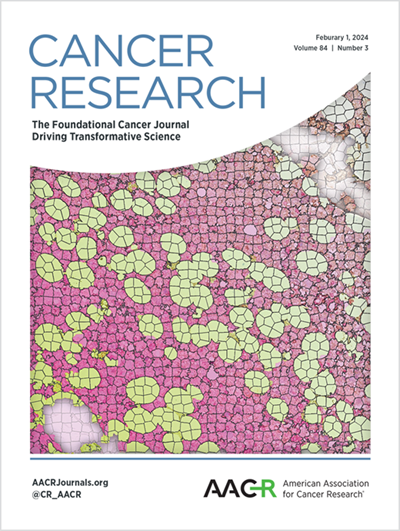从衰老的骨细胞隐窝中发现癌症引起的骨病
IF 12.5
1区 医学
Q1 ONCOLOGY
引用次数: 0
摘要
癌症引起的骨病极大地降低了骨转移性乳腺癌患者的生活质量,导致骨丢失和骨折等痛苦的骨骼相关事件。对成骨细胞和破骨细胞作用的进一步了解,以及肿瘤如何改变它们的生物学特性,已经带来了显著减少骨骼相关事件的重磅疗法,但这种疾病仍然无法治愈。然而,研究其他基质和免疫成分在控制肿瘤-宿主相互作用中的作用的新兴技术和工具已经开始揭示新的见解,可能产生易于处理的治疗靶点,以进一步减轻骨转移的痛苦影响。在这一期的《癌症研究》中,Kaur和他的同事研究了骨转移性乳腺癌的骨细胞,这是一种晚期分化的成骨细胞,埋藏在骨基质中,并报道了这种疾病是如何使它们衰老的,其特征是衰老相关的分泌表型。这种骨细胞衰老的过早发展反过来又增强了骨破坏和破骨细胞的潜力。使用抗衰老药物靶向衰老细胞抑制骨吸收和保存骨量。总的来说,这些发现强调骨细胞参与骨转移的“恶性循环”,并且靶向衰老骨细胞代表了治疗癌症诱导的骨病的新途径。参见Kaur等人的相关文章,第3936页本文章由计算机程序翻译,如有差异,请以英文原文为准。
Tales of Cancer-Induced Bone Disease from the Senescent Osteocyte Crypt
Cancer-induced bone disease greatly diminishes the quality of life for patients with bone metastatic breast cancer, resulting in painful skeletal-related events including bone loss and fracture. Improved understanding of the roles of osteoblasts and osteoclasts, and how tumors alter their biology, has led to blockbuster therapies that significantly reduce skeletal-related events, but the disease remains incurable. However, emerging technologies and tools for studying the role of other stromal and immune components in controlling tumor–host interactions have begun to reveal new insights that may yield tractable therapeutic targets to further mitigate the painful effects of bone metastases. In this issue of Cancer Research, Kaur and colleagues study osteocytes, which are terminally differentiated osteoblasts and entombed within the bone matrix, from established bone metastatic breast cancer and report how the disease ages them as characterized by a senescence-associated secretory phenotype. This premature development of osteocyte senescence in turn enhances bone destruction and osteoclastogenic potential. Targeting senescent cells using senolytics suppressed bone resorption and preserved bone mass. Collectively, these findings underscore osteocyte involvement in the “vicious cycle” of bone metastasis, and targeting senescent osteocytes represents a new avenue for managing cancer-induced bone disease.See related article by Kaur et al., p. 3936
求助全文
通过发布文献求助,成功后即可免费获取论文全文。
去求助
来源期刊

Cancer research
医学-肿瘤学
CiteScore
16.10
自引率
0.90%
发文量
7677
审稿时长
2.5 months
期刊介绍:
Cancer Research, published by the American Association for Cancer Research (AACR), is a journal that focuses on impactful original studies, reviews, and opinion pieces relevant to the broad cancer research community. Manuscripts that present conceptual or technological advances leading to insights into cancer biology are particularly sought after. The journal also places emphasis on convergence science, which involves bridging multiple distinct areas of cancer research.
With primary subsections including Cancer Biology, Cancer Immunology, Cancer Metabolism and Molecular Mechanisms, Translational Cancer Biology, Cancer Landscapes, and Convergence Science, Cancer Research has a comprehensive scope. It is published twice a month and has one volume per year, with a print ISSN of 0008-5472 and an online ISSN of 1538-7445.
Cancer Research is abstracted and/or indexed in various databases and platforms, including BIOSIS Previews (R) Database, MEDLINE, Current Contents/Life Sciences, Current Contents/Clinical Medicine, Science Citation Index, Scopus, and Web of Science.
 求助内容:
求助内容: 应助结果提醒方式:
应助结果提醒方式:


